Black Caterpillar 2 Yellow Vertical Stripes With Blue
Caterpillars are larvae in the class Insecta that turn into beautiful moths or butterflies. Striped caterpillars are some of the most striking caterpillars you will find in your garden or in the wild. Different species of caterpillars with stripes can be identified by their vibrant colors, hairiness, number of spines, or size. Some of the most interesting striped caterpillars have black, white, and yellow stripes and long horns.
Striped caterpillars, just like all caterpillars, are a type of insect belonging to the order Lepidoptera. Caterpillars start their life as eggs before turning into larvae. They have a voracious appetite as they eat their way through plant and tree leaves. As the larvae mature, they go through a number of growth stages.
Depending on the caterpillar genus, they can also be classed as furry caterpillars and come in a range of colors. Some striped caterpillars are green with black and yellow stripes. Others can be black or green with white or yellow bands. Some fierce-looking spiky caterpillars can be black with orange stripes and dots.
Striped Caterpillar Identification
In order to identify striped caterpillars, it's important to note their color, type of hairy covering, and specific markings. You should also note the specific colors of their stripes, spots or 'horns'.
It is important to remember that immature caterpillars may look completely different from mature larvae. The descriptions and identifying features of striped caterpillars here are of mature larvae before they enter the pupation state.
Types of Striped Caterpillars With Pictures
Let's look in more detail as some of the most fascinating types of striped caterpillars. Identifying the caterpillar characteristics will help to tell them apart. You will also find out which type of moth or butterfly these worm-like caterpillars turn into.
Monarch Butterfly Caterpillar

The Monarch caterpillar is yellow, white, and black striped caterpillar
The Monarch caterpillar (Danaus plexippus) is a striped caterpillar in the family Nymphalidae and genus Danaus. This crawling insect feeds on milkweed as it goes through its growth stages.
Also called the 'Common Tiger,' 'Wanderer,' or 'Milkweed' caterpillar, this caterpillar species turns into one of the most beautiful and iconic butterflies, the Monarch.
The Monarch caterpillar has black, white, and yellow bands wrapping around its segments. As the stripy caterpillar matures, a pair of horns grow at either end of its body. These are completely harmless and won't sting you.
Another identifying feature of the Monarch caterpillar is the white dots on its prolegs. These are the stumpy 'feet' on the middle segments of the caterpillar's body. Monarchs are a medium-sized species of caterpillar that can grow up to 2" (5 cm) long.
It is safe to handle these caterpillars as they don't bite, aren't poisonous, and don't have stinging spines.
Identifying features
A long fat type of caterpillar with yellow, white, and black stripes that contrast against green foliage on milkweed plants it feeds on.
Black Swallowtail Caterpillar
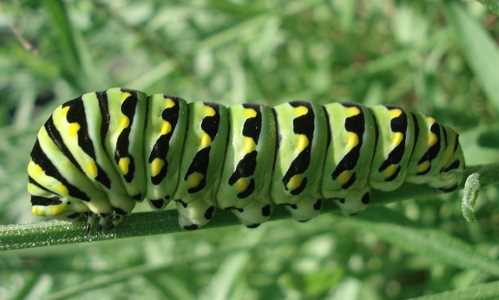
The Black Swallowtail Caterpillar can be identified by its black stripes and yellow markings on its green body
The Black Swallowtail butterfly caterpillar (Papilio polyxenes) is a green species of caterpillar similar to the Monarch. This plump green caterpillar belongs to the Papilionidae family in the order Lepidoptera.
You can tell the Black Swallowtail apart from the Monarch caterpillar because it looks green, not black. Each green segment has a black stripe with yellow markings wrapping around its body. The 4 pairs of green prolegs also have black dots on them.
One of the interesting features of this long fat caterpillar is its osmeterium. This is a kind of forked-tongue that the caterpillar sticks out from behind its head. The caterpillar also releases a foul-smelling stench when predators threaten it.
This green caterpillar species loves to feed on the leaves of carrots, dill, parsley, and other garden herbs.
Identifying features
This ugly green striped caterpillar totally transforms into the beautiful Black Swallowtail with its black wings and yellow, red, and blue markings.
Cinnabar Moth Caterpillar
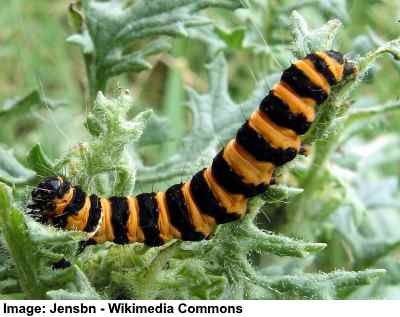
The Cinnabar caterpillar has orange and black striped body
The Cinnabar caterpillar (Tyria jacobaeae) has wispy spines sticking out from an orange and black striped body. This caterpillar from the family Erebidae turns into the cinnabar moth which is a beautiful black and red variety.
These caterpillars are ravenous feeders. They can quickly decimate plants of their leaves and may even then start eating each other.
The striking black and orange caterpillar is easily identifiable due to its colored segments. Black bands wrap around a yellow or orange body and long thin grayish hairs stick out. Even though these caterpillars eat a lot of leaves, they only grow to about 1.2" (3 cm) long.
Identifying features
Easy to spot feeding on ragwort due to its black and yellow/orange striped markings.
Queen Caterpillar

Queen Caterpillar has black and white stripes with yellow markings
Related to the Monarch butterfly, the larvae of the Queen butterfly (Danaus gilippus) looks like it has a white body with black stripes and yellow markings.
The Queen caterpillar is easy to recognize due to its unique combination of thin black stripes and wider black ones. It can be difficult to tell the Queen caterpillar and Monarch species apart. The Queen species has thicker black stripes that have yellow markings.
Another identifying characteristic of this black and white caterpillar are the pairs of long tentacles on its body. There is one pair at each end and a pair three-quarters along its length. Its head is black with white rings.
As the caterpillar matures, it becomes browner. Although black stripes are most common, species have been observed with yellow, green, blue, and dark brown stripes.
You can often find the Queen caterpillar in Southern states of USA such as Texas, Florida and it is common in Mexico and Central America.
Identifying features
A large fat hairless caterpillar with a smooth exoskeleton and a multitude of black and white stripes with yellow patches.
Striped Garden Caterpillar
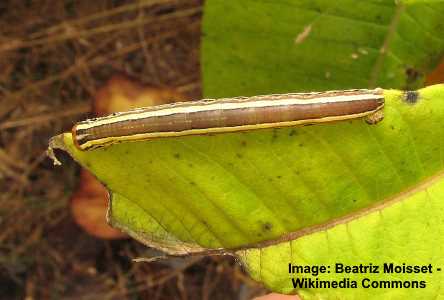
The Striped Garden Caterpillar has brown body with pale stripes along its sides
The Striped Garden caterpillar (Trichordestra legitima) looks like a long brown worm with light stripes running the length of its body. These are one of the most commonly found garden caterpillars.
Apart from the long yellowish-white stripes, you can identify this caterpillar by its globular brown head. Striped Garden caterpillars mainly feed on herbaceous plants such as cherry, raspberry, mustard, milkweed, and violets.
Identifying features
A type of non-stinging and harmless caterpillar, this species is identifiable by bright stripes running the length of its sides.
Orange Striped Oakworm Caterpillar
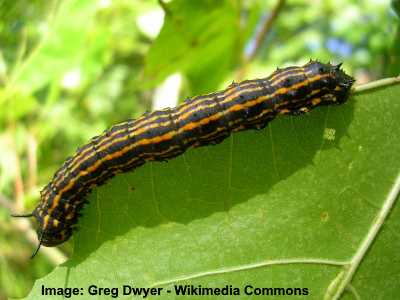
The Orange Striped Oakworm Caterpillar has black body with orange stripes along it
As its name suggests, the Orange Striped Oakworm (Anisota senatoria) is identified by a series of orange stripes running from head to tail. This horned caterpillar is completely harmless and won't sting you.
This black and orange species grows to about 2.5" (5 cm) and constantly feeds on oak leaves. Its black body also features tiny spines that give the caterpillar a spiky appearance. Some species of Orange-striped Oakworms have pink or yellow stripes.
These caterpillars from the Saturniidae family turn into beautiful yellow, pink, and orange-colored moths.
Identifying features
Prominent black horns at the head end of the stripy orange caterpillar with a slightly spiky back.
Giant Sphinx Caterpillar
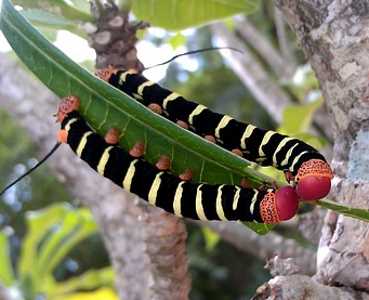
The yellow and black striped Giant Sphinx caterpillar has red/orange head and tail
The Giant Sphinx caterpillar (Pseudosphinx tetrio) is appropriately named due to its large size. This is one of the biggest striped caterpillars you are likely to come across as it can grow up to 6" (15 cm).
You can easily identify the Giant Sphinx due to the white bands on its long fat black body. The head and tail ends are a brownish-orange or red color and there is a long protruding spike at the tail end. Another interesting feature of this stripy caterpillar is the 4 pairs of red-orange prolegs.
As you would expect from a striped caterpillar this size, it turns into a large moth with a wingspan of over 1 foot (30 cm)!
The Giant Sphinx is also a stinging species of caterpillar. Fine urticating hairs cover the caterpillar's body and can cause skin irritation when handled. This is also one of the few caterpillar species that bite if caught.
Identifying features
A huge type of caterpillar with yellowish bands around each segment. The orange prolegs and head and its enormous size make this caterpillar easy to identify.
White-Lined Sphinx Caterpillar
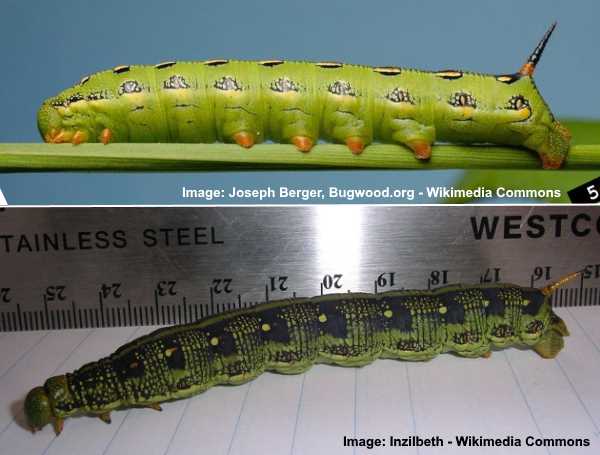
White-Lined Sphinx Caterpillar has many color variations depending on its growth stage
The White-lined Sphinx moth caterpillar (Hyles lineata) is a green species of caterpillar with 2 white lines running up its side. There are many variations in color of these caterpillars from the Hyles genus.
The larvae of the White-lined Sphinx moth have orange or black spots running in lines down the body. Some species can be a yellow color with black stripes. However, sometimes the caterpillar can be lime-green with lines of black dots and yellow stripes.
One of the identifying features of these caterpillars is the black-tipped orange or yellow horn at its tail end. Although this looks like a sharp spike, the protruding tail is completely harmless.
Identifying features
Stripes and dotted black markings along with a solitary horn at its tail help to identify this type of crawling insect.
Zebra Caterpillar
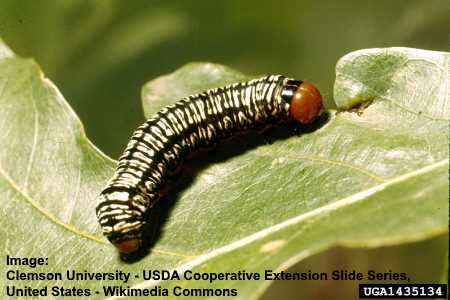
The black and white striped zebra caterpillar can be identified by its reddish-brown head
As its name suggests, the Zebra caterpillar (Melanchra picta) has black and white stripes crisscrossing its segments. This caterpillar species is also identified by yellow stripes running the length of the long body.
You can often find Zebra caterpillars munching their way through cabbage leaves. These moth larvae start off white with black heads. As the caterpillars mature, they become more colorful. Black and bright yellow stripes line their body. There are white striped patterns giving some species a marbling effect.
To spot this leaf-hungry caterpillar, look out for a reddish-brown head with light-colored legs.
Identifying features
Striking black, white, and yellow stripes identify this caterpillar that can grow to 1.6" (4 cm) long.
Brown Hooded Owlet Striped Caterpillar
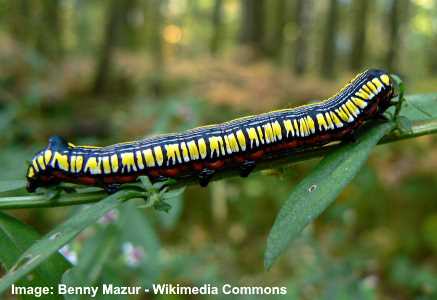
The Brown Hooded Owlet caterpillar has black body with yellow stripes and red dots
Belonging to the family Noctuidae, the Brown Hooded Owlet caterpillar (Cucullia convexipennis) looks similar to Zebra moth caterpillar. In fact, some people call this a zebra caterpillar.
There are a few ways to identify this caterpillar apart from the Zebra caterpillar. There is a pronounced stump at one of its ends. A black stripe with faint white markings runs up its back. Along the sides are yellow stripes and a line of red dots.
You can often find the Brown Hooded Owlet caterpillar feeding on asters and goldenrods. After the pupation stage, the larvae turn into large gray moths.
Identifying features
A colorful caterpillar featuring black, white, yellow, and red colors.
Azalea Caterpillar
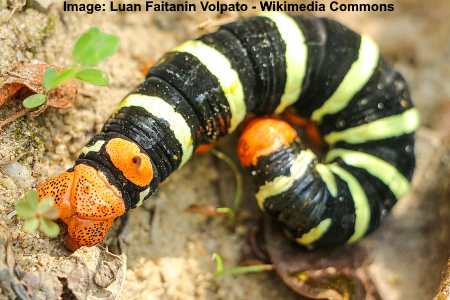
The Azalea Caterpillar has a stripy green and black body with orange head and tail
Azalea caterpillars (Datana major) are unusual in that they have a large round head in relation to their green striped body. These hungry caterpillars feed in clusters and can quickly destroy azaleas as they feed on their leaves.
The coloring on Azalea caterpillars is pale green and yellow/orange. Wide black strips and thinner green stripes run along its body. The caterpillar's head is rusty brown or orange and oval and it has a smaller brownish tail. There are also spindly light hairs sprouting from its head.
Although these are not a dangerous type of caterpillar, an infestation can cause havoc in a garden. They feed on azaleas, rhododendrons, apples, and blueberries.
Identifying features
Ravenous munching caterpillars with a brown or orange globular head and a stripy green and black body.
Angle Shades Moth Caterpillar
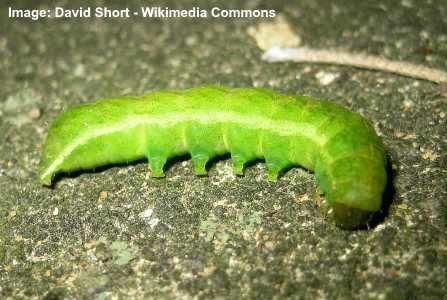
The Angle Shades Moth Caterpillar has bright green body and pale stripe on each side
The Angle Shades caterpillar (Phlogophora meticulosa) is a lime-green type of larvae with a pronounced pale stripe on each side.
Apart from the long stripe on each side of its back, there are faint yellowish dorsal lines separating the segments. Although green is the most common color of this species, there are also pinkish-brown types of larvae with similar stripes.
The green color of this striped moth caterpillar is excellent camouflage against green leaves.
Identifying features
You can tell this caterpillar apart from other species due to its lack of hairs and spikes and a single white-yellow stripe along its sides.
American Painted Lady Caterpillar
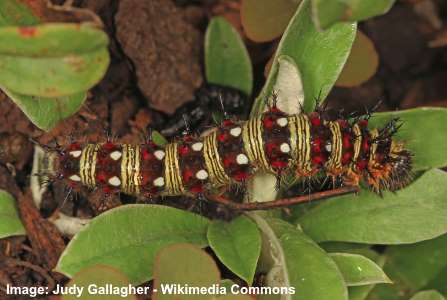
The American Painted Lady Caterpillar has pale stripes on its dark body with red and white dots
The American Painted Lady butterfly caterpillar (Vanessa virginiensis) is a stripy black fuzzy caterpillar with a number of horny spikes on it.
The stripes on the American Painted Lady are whitish or pale yellow bands on a dark brown body. These dorsal stripes separate each segment of this scary-looking caterpillar. The caterpillar is easily identified by the branched spines on its body. You will also notice red and white dots in between the white stripes.
Identifying features
Look for jaggy-looking spines that stick out from its back and sides along with white bands.
Cross-Striped Cabbageworm
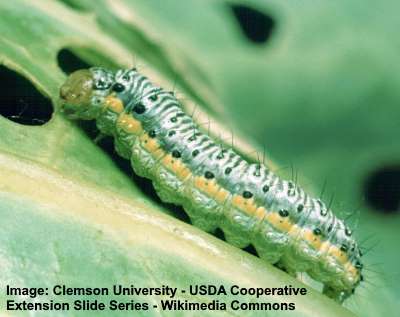
The Cross-Striped Cabbageworm has green body, white marks on the back and yellow stripe on each side
Although called a 'worm,' the Cross-Striped Cabbage worm (Evergestis rimosalis) is a type of striped caterpillar with various colored markings. As its name suggests, these zebra-like caterpillars are stripy and eat cabbages.
The larvae of the Cabbage worm belong to the family Crambidae and they turn into beautiful butterflies. These caterpillars generally have green bodies, green prolegs, and a green head. Yellow stripes run up their sides and they have rows of green and black dots. You will also notice eye-like markings on their backs.
Looking up close, you will also notice fine spines sticking out from its back. The best way to stop these pesky insects destroying your crops is to pick them off by hand. Their fine spines don't sting and they are harmless caterpillars.
Identifying features
An oval head that is a light brown color and a green body with spot markings and lateral stripes.
Angus Datana Moth Caterpillar
Native to North America, the Angus Datana caterpillar (Datana angusii) is a type of stripped furry caterpillar. Although this isn't as fuzzy as a woolly bear, it has long spindly spines all over its body.
The main identify feature of these fuzzy caterpillars are the black and white or yellow strips running the length of its body. Clusters of whitish-gray wispy hairs grow from each segment. One identifying aspect of this long black caterpillar is its black oval head.
Gulf Fritillary Caterpillar
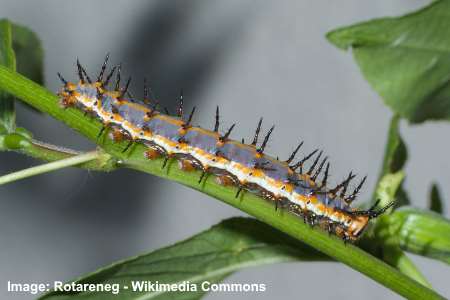
The Gulf Fritillary Caterpillar has gray or brown spiky body with white and yellow stripes along its sides
One colorful example of a stripy spiky caterpillar is the Gulf Fritillary caterpillar (Agraulis vanillae). These brightly colored caterpillars are found in regions in Texas and Florida.
Jaggy looking spines stick out from its back and sides. The caterpillar has a dark brown or gray back that has an orange/yellow stripe on either side. Along its sides runs a single white stripe.
You can expect to find this species of caterpillar munching away on plants in the Passiflora group. This caterpillar transforms into a butterfly which is just as colorful.
Rosy Maple Caterpillar

The rosy maple caterpillar has light green and white stripes with black dots
The Rosy Maple caterpillar (Dryocampa rubicunda) is a large plump caterpillar with light green and white stripes. In some ways, the striped markings can resemble hard-boiled candies.
This species of caterpillar is easy to identify due to the stripy pattern running down its length. The back has wider white stripes with thin green ones and the sides have wider green stripes. Another feature of this caterpillar is the small black dots on the sides of each of its segments.
You can also tell this caterpillar apart from others by its reddish head and the red markings on its tail end. There are also 2 black horns poking out from its head and small black spikes on its rear end and prolegs.
After the pupation stage, the larvae emerge as some of the most beautiful moths in North America. The moth's body and wings are shades of pinks and orange.
Frequently Asked Questions about Striped Caterpillars
Are striped caterpillars poisonous?
Caterpillars with stripes are generally harmless and won't sting you. Usually, fuzzy caterpillars are the dangerous type as they have urticating hairs that contain toxins. These can break off in your skin and cause irritation, hives, and swelling.
What do stripy caterpillars feed on?
Stripy caterpillars feed on leaves of plants and trees. Some stripy caterpillar species such as the Monarch caterpillar feeds exclusively on milkweed. Other species of striped caterpillar feed on various other plant matter. There are also some types of stripy caterpillars that eat other insects or even other caterpillars.
Related articles:
- Stinging Caterpillars with An Identification Chart and Pictures
- Black Caterpillar Identification and Guide
- Types of Green Caterpillars with Identification Guide
Read Next
tomlinsondurs1989.blogspot.com
Source: https://leafyplace.com/striped-caterpillar/
0 Response to "Black Caterpillar 2 Yellow Vertical Stripes With Blue"
Post a Comment